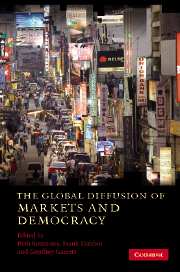Book contents
- Frontmatter
- Contents
- List of appendixes
- List of figures
- List of tables
- Notes on contributors
- Acknowledgements
- 1 Introduction: the diffusion of liberalization
- 2 Tax policy in an era of internationalization: an assessment of a conditional diffusion model of the spread of neoliberalism
- 3 The decision to privatize: economists and the construction of ideas and policies
- 4 The international diffusion of public sector downsizing: network emulation and theory-driven learning
- 5 Global ideology and voter sentiment as determinants of international financial liberalization
- 6 Competing for capital: the diffusion of bilateral investment treaties, 1960–2000
- 7 Diffusion and the spread of democratic institutions
- 8 World society and human rights: an event history analysis of the Convention on the Elimination of All Forms of Discrimination against Women
- 9 Conclusion
- Index
- References
8 - World society and human rights: an event history analysis of the Convention on the Elimination of All Forms of Discrimination against Women
Published online by Cambridge University Press: 04 August 2010
- Frontmatter
- Contents
- List of appendixes
- List of figures
- List of tables
- Notes on contributors
- Acknowledgements
- 1 Introduction: the diffusion of liberalization
- 2 Tax policy in an era of internationalization: an assessment of a conditional diffusion model of the spread of neoliberalism
- 3 The decision to privatize: economists and the construction of ideas and policies
- 4 The international diffusion of public sector downsizing: network emulation and theory-driven learning
- 5 Global ideology and voter sentiment as determinants of international financial liberalization
- 6 Competing for capital: the diffusion of bilateral investment treaties, 1960–2000
- 7 Diffusion and the spread of democratic institutions
- 8 World society and human rights: an event history analysis of the Convention on the Elimination of All Forms of Discrimination against Women
- 9 Conclusion
- Index
- References
Summary
A worldwide human rights regime has emerged, expanded, and intensified throughout the twentieth century, especially in the post-Second World War era. This regime involves a global system of expanding organizations, social movements, conferences, rules, and discourse promoting the human rights of individuals. This regime is universalistic in aspiration: all humans are expected to be covered by the regime. This universalism involves a discursive and organizational reframing of the more limited and more varying national citizenship emphasis; human rights in principle accrue to all individuals, regardless of their citizenship or residency. And, a growing number of types of individual persons can press for their human rights: women, children, ethnic minorities, indigenous peoples, gays and lesbians, the elderly, the disabled, and the imprisoned. The content of the human rights at stake also expands, from the rights of “abstract individuals” to the rights of individual members of a specific collectivity, e.g. from suffrage to reproduction rights for women. Also on the rise is both worldwide attention to human rights abuses and violations and national displays of commitment to human rights principles and policies. These unexpected developments have increasingly been highlighted by scholars working within both the disciplines of international relations (e.g. Donnelly 1986; Finnemore and Sikkink 1998; Keck and Sikkink 1998; Hathaway 2002; Vreeland (forthcoming)) and macrosociology (Hafner-Burton and Tsutsui 2005; Tsutsui and Wotipka 2004; Smith 1995; Soysal 1994).
- Type
- Chapter
- Information
- The Global Diffusion of Markets and Democracy , pp. 303 - 343Publisher: Cambridge University PressPrint publication year: 2008
References
- 87
- Cited by

